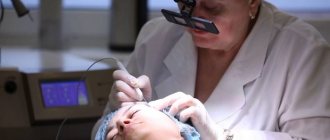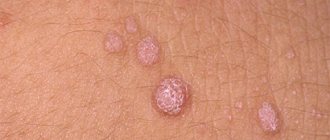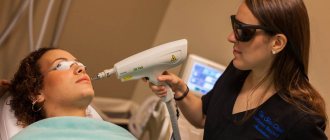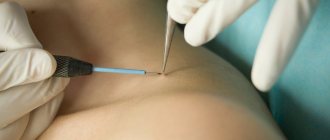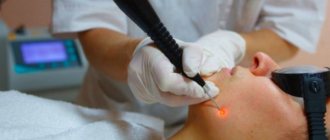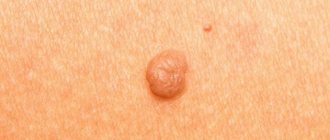Papilloma is a benign formation, the growth of which is caused by the human papillomavirus. In most cases, it occurs against the background of chronic pathologies or weakened immunity. Formations make adjustments not only to the patient’s appearance, but can also affect health. They aggravate breathing, cause discomfort and provoke the development of diseases. Radio wave surgery is used to remove papillomas. What do you need to know about the method, what is it based on and what are the consequences of the intervention?
Basis of the method
Removal of tumors is carried out using high-frequency radio waves supplied by a special device. This operation is reminiscent of a surgical one, with the difference that instead of a traditional scalpel, the doctor holds a radio wave knife in his hands. In addition, the procedure itself is carried out in a non-contact manner, i.e. The device does not affect skin or mucous membranes.
During tissue excision with a radioknife, areas are cut, but the cells in them evaporate and are not separated as during surgical operations. Radio wave destruction is effective both for single papillomas and for multiple groups of growths. The peculiarity of the action of radio waves is that they can affect tumors in different, even the most inaccessible places. Thus, the method is used not only on open areas of the body, but also in the eyelids, armpits, genitals, etc.
Preventive measures
Radio wave removal is an effective and safe method of treating papillomas. But preventing their occurrence is much easier. Methods for preventing HPV infection are:
- Vaccination. Gardasil and Cervarix vaccinations protect against the most oncogenic types of papillomatosis virus. Girls over 8 years of age and women who are laboratory-determined to be free of HPV are vaccinated on a voluntary basis.
- Using a condom. Protected sex reduces the risk of contracting the virus. But the pores of a latex condom are large enough for virus particles, so the method cannot be 100% effective. With each new sexual partner, the possibility of infection increases tenfold.
- Annual gynecological examination. Women who are sexually active are advised to visit an obstetrician-gynecologist at least once a year. This will allow us to detect initial precancerous processes in the cervix and begin timely therapy.
- Compliance with personal hygiene rules. Transmission of HPV is possible through contact and household contact with hygiene items, towels, and cosmetics of carriers of the disease. Viral particles are found in large quantities in all human biological fluids - saliva, blood, urine, sweat, semen and vaginal lubrication.
- Strengthening the immune system. For the disease to develop, it is not enough just for the virus to enter the body. In order for viral particles to penetrate epithelial cells and cause their uncontrolled growth, it is necessary to reduce the body's defenses. Proper, balanced nutrition, moderate physical activity, avoiding alcohol and nicotine, hardening, and preventing stressful situations and overwork will help strengthen your immune system. If you have chronic diseases, you must undergo an annual examination by specialized doctors and follow all medical prescriptions.
Radio wave removal is a good replacement for a scalpel and other traumatic methods of reducing papillomas. Radiocoagulation is safe, leaves no traces and is used for any location and shape of the growth. Its main disadvantage is the high cost and complex equipment.
The method of treating papillomas is chosen by the doctor only after an examination. High efficiency is achieved with high-quality implementation of the procedure and compliance with all medical instructions in the postoperative period. If you experience any discomfort after a papillomas removal session, you should immediately consult a doctor.
Removal device
Removal of papillomas is carried out using the Surgitron device, which is considered a universal tool for the destruction of various neoplasms. The device is capable of removing not only papillomas, but also nevi, warts and erosions.
“Surgitron” operates on waves with a frequency of about 4.0 MHz, due to which fluid evaporates from the affected cells. The device is directed by a doctor, so during the operation there is no risk of injury to healthy areas.
In addition, the device has several electrodes, thanks to which a targeted effect is achieved even in hard-to-reach places.
What do papillomas really look like?
Very often, people who come to see me to remove papillomas call them other skin tumors. Fibropapillomas, keratopapillomas, pigmented nevi. That is why, before removal, you should definitely determine whether you really have papillomas.
Most often, this is a small, 1-3 mm skin formation on a thin stalk. There are three main differences between papilloma and other skin formations. First
- the leg is always thinner than the upper part.
Secondly
, the consistency of papilloma is always softer than the surrounding skin.
Third
, the size of the papilloma is usually small - no more than 5 mm. The photo below shows typical papillomas.
Advantages and disadvantages
Radio wave destruction has many advantages over other removal methods:
- non-invasiveness of the procedure;
- bloodlessness of the operation;
- removal of growths from difficult areas;
- absence of trauma at the site of injury;
- the possibility of performing histology of the removed growth;
- carrying out sterilization of wounds during the removal process;
- no complications after surgery.
Among the disadvantages of the method, one can highlight the cost of the procedure, which is higher than for other removal methods. In addition, radio wave destruction is not suitable for removing large tumors, which must be removed only through surgery.
Practicing dermatovenerologist Lenkin Sergey Gennadievich will tell you about the radio wave method for removing condylomas and papillomas:
Advantages and disadvantages
A large number of advantages have made radio wave surgery the method of choice in many clinics:
- painlessness of the procedure;
- non-invasive and non-contact;
- minimal trauma;
- high cosmetic effect, absence of scars and cicatrices;
- speed of implementation;
- relative cheapness;
- the ability to remove tumors of all locations, including removal of papillomas in intimate places;
- destruction of all types of papillomas and condylomas - the radioknife removes all neoplasms of any size and histological types;
- influence only on the pathological focus, there is no effect on surrounding healthy tissue;
- no risk of infectious complications;
- There is no need for hospitalization, anesthesia or other drug therapy.
In addition, the radiosurgery procedure does not require special postoperative care.
It is performed with sterile knives and does not leave wounds on the surface of the skin into which microorganisms can penetrate. Radio wave removal of papillomas is a manipulation whose price is lower than laser destruction. With a large number of tumors, the difference in cost is significant. The radiosurgical method has virtually no disadvantages. The only disadvantage is that the manipulation is not radical; there is always the possibility of tumor recurrence. The method is not used as a treatment for HPV infection, but is only a surgical corrective procedure.
Contraindications
Despite the safety and painlessness of the procedure, it also has its contraindications. Among them:
- the presence of malignant tumors;
- period of pregnancy or lactation;
- exacerbation of chronic diseases;
- acute form of infectious diseases (herpes, influenza, etc.);
- heart pathologies;
- diabetes.
In addition, the use of a device with radio waves requires the absence of any devices powered by electricity. Therefore, radio wave removal is not suitable for patients with pacemakers. Patients with other devices, such as hearing aids, will need to remove them before the session.
Additional treatment
The human papillomavirus is the main culprit in the development of benign growths on the skin and mucous membranes. Some of its types (16,18,51,52) cause malignant tumors of the cervix and ovaries. To prevent the development of cancer and prevent the reappearance of papillomas, antiviral therapy is prescribed in addition to radio wave removal. Its use is preceded by a PRC analysis for HPV to determine its type.
The main drugs for the treatment of papillomatosis virus are:
- Interferons. These are special proteins produced by the immune system to destroy the virus. Available in the form of tablets (Cycloferon, Interferon), intramuscular and intravenous injections (Reaferon), rectal and vaginal suppositories (Viferon).
- Interferon inducers: Polyoxidonium, Neovir, Roncoleukin. Helps increase the activity of the immune system and has a general strengthening effect.
To increase the body's defenses, a course of vitamins (especially groups B and C) and herbal adaptogens (tincture of ginseng, eleutherococcus, echinacea) is prescribed.
Stages of the procedure
The removal of the growth itself is quick, but before this the patient needs to prepare for the procedure. Thus, the process of removing a tumor takes several stages.
Preparatory stage
Any operation to destroy existing growths should be carried out under the supervision of a dermatologist. At this stage, the sequence of actions will be as follows:
- Initial examination. During the examination, the type of tumor is determined, a medical history is taken, and a method for removing the growth is selected. The presence of contraindications and pathologies in the patient is determined. If any, additional treatment is prescribed before removal.
- Taking tests. In addition to general tests prescribed for any intervention, papillomas must be studied using histology. This is necessary in case the tumor turns out to be malignant. Such growths cannot be removed using the usual procedure.
- Setting a date for surgery. If the patient has no contraindications to the procedure, the doctor appoints a day for the procedure.
Radio wave cutting of warts in children
Radio wave therapy does not last long and does not cause discomfort or pain, so it is prescribed even to children. To refer a child for the procedure, he must undergo an initial examination and diagnosis by a dermatologist.
The patient undergoes a general analysis of urine and blood, as well as an allergy test for drugs that are part of the local anesthesia.
During the procedure, the dose of radio radiation is minimal, which is why there is no potential danger to the child’s body. Nowadays, most private clinics perform radio wave cutting of papules for young children and guarantee a positive result.
Consequences
Removal of any tumors using Surgitron is a safe, non-invasive intervention. During and after the operation, the patient practically does not feel any discomfort.
Radio wave destruction is not characterized by complications such as burns, swelling or inflammation. The recovery period passes quite quickly, and the frequency of relapses with proper therapy is minimal.
Before removal
After removal
Features of skin care after the procedure
For the first 3 days after removal of the papilloma using the radio wave method, you need to re-dress the wound every day, treat the wound surface with an antibacterial ointment or solution prescribed by your doctor. During this time, a thin crust forms, under which healthy skin begins to form.
In order not to disrupt the healing process, it is recommended not to apply cosmetics to the affected area for 1-1.5 weeks, not to visit the bathhouse, sauna or swimming pool, and to carefully treat the wound with a warm soapy solution. It is forbidden to tear off the crust; this may lead to the formation of a cosmetic defect. It should fall off on its own.
Complete wound healing occurs within 2 months. By this time, not even the slightest trace of the procedure remains on the skin. During the recovery period, you should avoid excessive insolation - you should avoid going to the solarium and prolonged exposure to the sun. If your health worsens or discomfort occurs in the postoperative wound, you should consult a doctor.
Care
The radio wave removal method is considered a light intervention, so a second visit to the doctor is not required after the procedure. There are no stitches after the operation, and there is no need for complex daily treatment. Therefore, the patient will be able to perform all care procedures independently.
After radio wave destruction, a scab appears at the site of removal.
It performs a protective function, protecting damaged tissues from the penetration of microbes and aggressive environmental influences. This area must be treated several times a day with antiseptic and regenerating drugs. This will make the entire healing process faster. Usually healing ends after 5-7 days , after which the crust disappears. You should not touch it or try to separate it yourself.
After this, the scab will separate, and underneath there will be clean skin. It turns out to be a different shade and differs from neighboring skin. This is considered normal and does not affect the patient’s health in any way. A small scar usually remains at the site of removal of the growth, which disappears 1-3 months after the procedure.
Rehabilitation after removal of papillomas using radio waves
To quickly restore the skin at the surgical site and prevent the development of inflammatory processes after removal of papillomas with radio waves, the specialist prescribes antiviral and antibacterial drugs. It is also possible to use restorative ointments and topical gels.
At the site of the papilloma, a dried blood crust forms - a scab. It prevents dirt and infection from getting inside. During the rehabilitation period, it is recommended to regularly treat it with antiseptic solutions. Do not wet surgical sites, expose them to direct sunlight, or use cosmetics. Also, the wound must be protected from mechanical stress so as not to damage the protective crust.
The complete healing time, after which the crust disappears on its own, is 1 week. At first, skin may form in its place, which differs in color and structure from normal. But a few months after the removal of papillomas by radio waves, no differences are observed.
Which is better: radio wave removal or laser
Each technique has its own advantages and disadvantages. Thus, radio wave destruction is more intended to remove convex tumors that rise significantly above the skin. The laser can deal with both convex and flat tumors.
Both methods are effectively used both on mucous membranes and on the skin. They also work on the same principle: evaporation of cells in the affected area. However, the radio wave method has an advantage over the laser method in the healing period. So, a scab after laser destruction heals in about 1.5-2 weeks, while after radio waves the crust disappears after about 1 week.
In addition, the Surgitron device, which operates on the basis of radio waves, is the most common equipment in clinics due to its versatility. While equipment for laser removal is not available in every hospital, since such a device is of a narrower specialization.
What are warts?
Neoplasms arise due to a number of reasons: weakened immunity, stressful situations, microtrauma of the skin, non-compliance with personal hygiene rules. The result of these factors is the appearance of condylomas on the epidermis. Their localization can be anywhere - from the skin of the hands and feet, ending with the face and intimate areas.
Content:
- What are warts?
- Features of radio wave wart removal
- Indications and contraindications for the procedure
- Benefits of radio wave wart removal
- How is removal done using radio waves?
- Radio wave cutting of warts in children
- Rehabilitation period
Papules can grow throughout life and reach a diameter of 2 centimeters. The biggest danger of papillomas is that they can transform from benign to malignant. Malignant growths are called melanomas, which can still be cured in the early stages of the disease, so you should not delay a visit to the doctor.
You should not self-medicate, and take alternative medicine methods especially seriously. Celandine, acetic acid, garlic and other methods do not always save you from serious diseases, plus they can have a negative effect on the skin where the wart is located.
After a thorough examination, the specialist determines the type of tumor and prescribes a course of treatment. The most effective ways to get rid of defects on the epithelium are radio wave methods, laser technologies, cauterization with liquid nitrogen and surgical procedures.
approximate price
The cost of removing tumors using the radio wave method can vary significantly depending on several parameters. So, first of all, the number of papillomas to be removed, as well as their size, is taken into account. Usually, when removing growths of more than 5 (sometimes 10), clinics give a small discount. In this case, the cost of removing one papilloma can vary from 300 to 750 rubles .
In addition, the area in which the removal will be carried out will be significant in determining the cost. Thus, growths in the perianal area cost on average 500-700 rubles per unit, but sometimes the price can reach up to 2000 rubles, depending on the complexity. Papillomas in the scalp or on the face cost 300-400 rubles.
Features of using a radio knife for papillomas
Radio wave surgery removes growths by cutting and coagulating soft tissue under the influence of radio waves. In addition to warts, dilated veins due to hemorrhoids, moles, keratoses, nasal polyps, lipomas, and granulomas are also affected.
The operating principle of the Surgitron or ATMOS RS 221 devices is a bloodless incision and coagulation of tumor cells and vessels.
The gentle effect is achieved due to tissue resistance to concentrated energy.
Waveguide types:
- round loop;
- loop in the form of a triangle - sail;
- spherical electrode;
- scalpel.
Radio waves have an effect with great precision, and cauterization of blood vessels around the growths prevents further spread of the virus. There is no indirect contact of the electrode with healthy skin, removal of papillomas using a radioknife does not cause pain in the patient, and there is no stimulation of formations at the ends of the nerve fiber processes.
How does the wart removal procedure work?
Need advice from an experienced doctor?
Get a doctor's consultation online. Ask your question right now.
Ask a free question
Radio wave removal of papilloma is carried out in a medical institution. The doctor's office must be equipped with a Surgitron apparatus and an exhaust hood; inhaling fumes during manipulations is dangerous to the health of the patient and medical personnel. The procedure is performed by a dermatologist, urologist or gynecologist. It is prohibited to remove vegetation outside of medical institutions. It is fraught with complications and the inability to provide qualified assistance in unforeseen situations.
No special preparation is required. If condylomas on the genitals are to be removed, it is advisable for girls to carry out the procedure immediately after completion or, at most, 2 days after their period. The patient must inform the doctor about medications taken on an ongoing basis and the presence of allergic reactions to anesthetic agents.
The sequence of manipulations for radio wave removal of warts:
- The patient is seated in a chair; when removing condylomas in women, he is seated in a gynecological chair.
- An aerosol spray of anesthetic is sufficient; conduction or injection anesthesia is not required.
- The location of the formations is separated from healthy areas with gauze or disposable napkins, forming the surgical field.
- The doctor brings the waveguide to the wart and removes it layer by layer. At the same time, small vessels are cauterized, no blood is released, and the wound surface is disinfected.
- After the vegetation is removed, a wound is formed. It is sterile and does not require additional treatment with an antiseptic. Minor pain may be present.
After removing warts using the radio wave method, the doctor will explain how to care for the wound and prescribe medications for treating the skin and mucous membranes.
